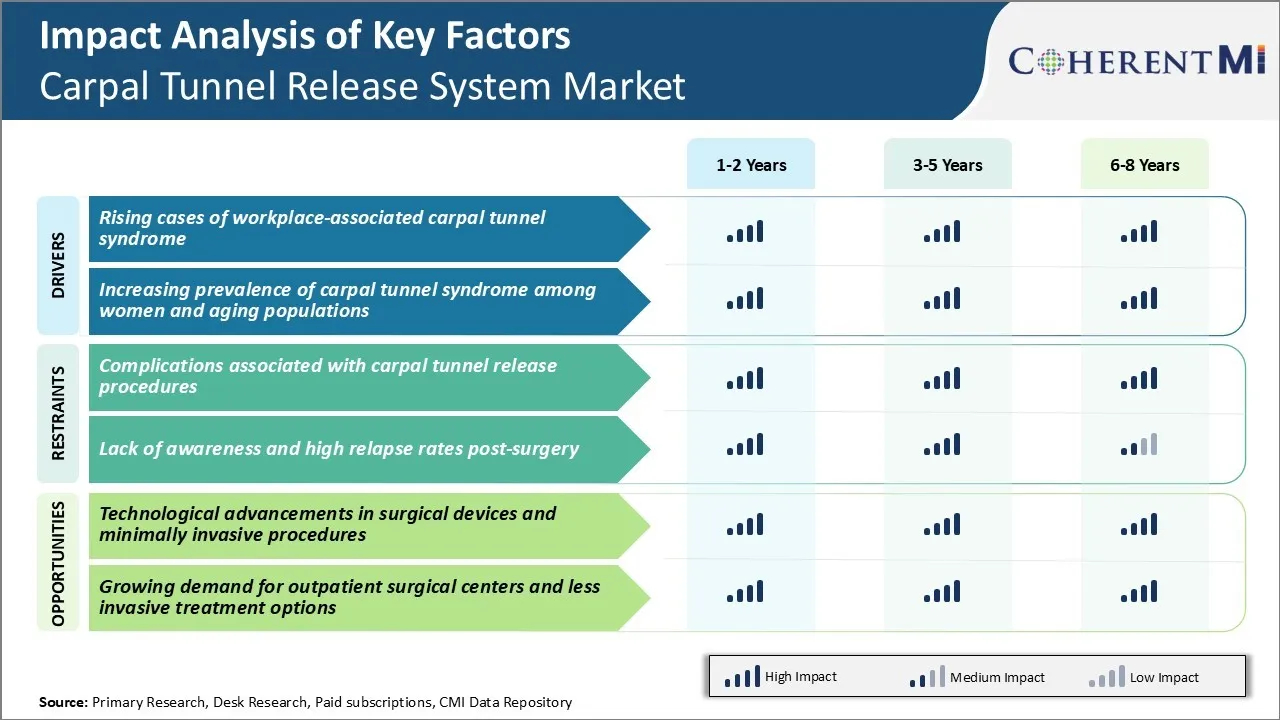Carpal Tunnel Release System Market Trends
Market Driver - Rising Cases of Workplace-Associated Carpal Tunnel Syndrome
Prolonged exposure to repetitive hand and wrist motions required for activities like typing on keyboard and mouse usage, assembly line work, and equipment handling has made workers more prone to developing carpal tunnel syndrome. Carpal tunnel (CT) syndrome occurs when the median nerve located in the carpal tunnel of the hand gets compressed or squeezed.
Occupations involving intensive and regular use of hands and wrists like data entry operators, customer service representatives, engineers, factory workers have seen a concerning rise in CT cases in recent years. Help desk operators and call center employees who have to maintain unnatural wrist postures for extended periods while using computer keyboards or phones are particularly at high risk.
The demanding production targets and performance metrics in manufacturing plants often do not allow workers sufficient breaks and rest periods. Even white-collar professionals working in offices have reported increasing symptoms of CT due to longer duration of computer usage.
With evolving job roles and work cultures across industries, the risk factors for developing CT seem to be continuously growing in the professional environment. This surge in occupation-linked CT cases indicates a potential rise in demand for carpal tunnel release procedures and postoperative rehabilitation therapies.
Market Driver - Increasing Prevalence of Carpal Tunnel Syndrome among Women and Aging Populations
Carpal tunnel syndrome has historically affected women more than men. It is estimated that women are nearly 3 times more likely than men to develop CT. Biological and anatomical reasons have been associated with this gender predisposition. Women naturally have smaller carpal canals which cramp the median nerve more tightly.
Additionally, hormonal changes during menstrual cycles and pregnancy can cause the hands and wrist to swell leading to further nerve compression. With rising women workforce participation and dual-income households now common globally, women are just as actively engaged in high-risk jobs and activities as men, increasing their exposure to causative factors.
Age is another prominent non-occupational risk factor for CT. As people grow older, the synovial tissues in the carpal tunnel tend to thicken gradually due to normal wear and tear. Combined with loss of muscle strength and grip, the median nerve gets more easily entrapped in the wrist.
With advancements in medicine improving life expectancy, populations across countries are rapidly greying. The combination of innate biological predispositions and a proliferation of susceptible age groups points towards a scenario of enhanced CT prevalence rates among women and senior citizens globally. The needs for surgical and therapeutic interventions are expected to escalate accordingly.

Market Challenge - Complications Associated with Carpal Tunnel Release Procedures
There are several complications associated with carpal tunnel release procedures that pose challenges to the growth of the carpal tunnel release system market. One of the major challenges is nerve injuries resulting from surgical errors during open carpal tunnel release procedures. Performing intricate manual procedures in a narrow anatomical space increases the risks of injuring the median nerve branches passing through the carpal tunnel.
Post-operative median nerve damage or incomplete release of the transverse carpal ligament can result in continued symptoms or new symptoms like pain and tingling in the hand and fingers. Device-related complications due to breakage or migration of fixation devices like screws also negatively impact the clinical outcomes.
Persistent symptoms and loss of hand function due to complications often require revision surgeries, adding to the treatment costs and reducing patient satisfaction with the procedure. The risks and medico-legal liabilities associated with open surgery make both patients and surgeons cautious about relying only on conventional procedures.
Market Opportunity - Technological advancements in surgical devices and minimally invasive procedures
The carpal tunnel release system market has been presented with significant growth opportunities owing to technological advancements in endoscopic and minimal access surgical devices. Minimally invasive endoscopic carpal tunnel release systems have revolutionized the procedure by enabling surgeons to access the carpal tunnel through a small incision with the aid of an endoscope and specialized cutting and widening devices. This reduces tissue trauma compared to open techniques and lowers the risks of nerve injuries, scarring and complex regional pain syndrome. It also allows for faster recovery and return to normal activities.
Advancements like mechanized cutting and tissue dilating components in endoscopic portals have improved ergonomics and consistency in application. With rising adoption, further refinement of these closed procedures could help address the complications restricting the carpal tunnel release system market potential for open carpal tunnel surgeries. Emerging technologies integrating robotics, haptics and 3D imaging are also expected to enhance precision and outcomes of minimally invasive carpal tunnel release.